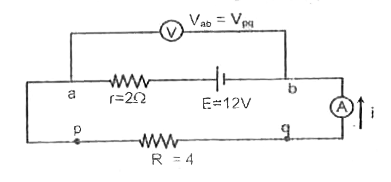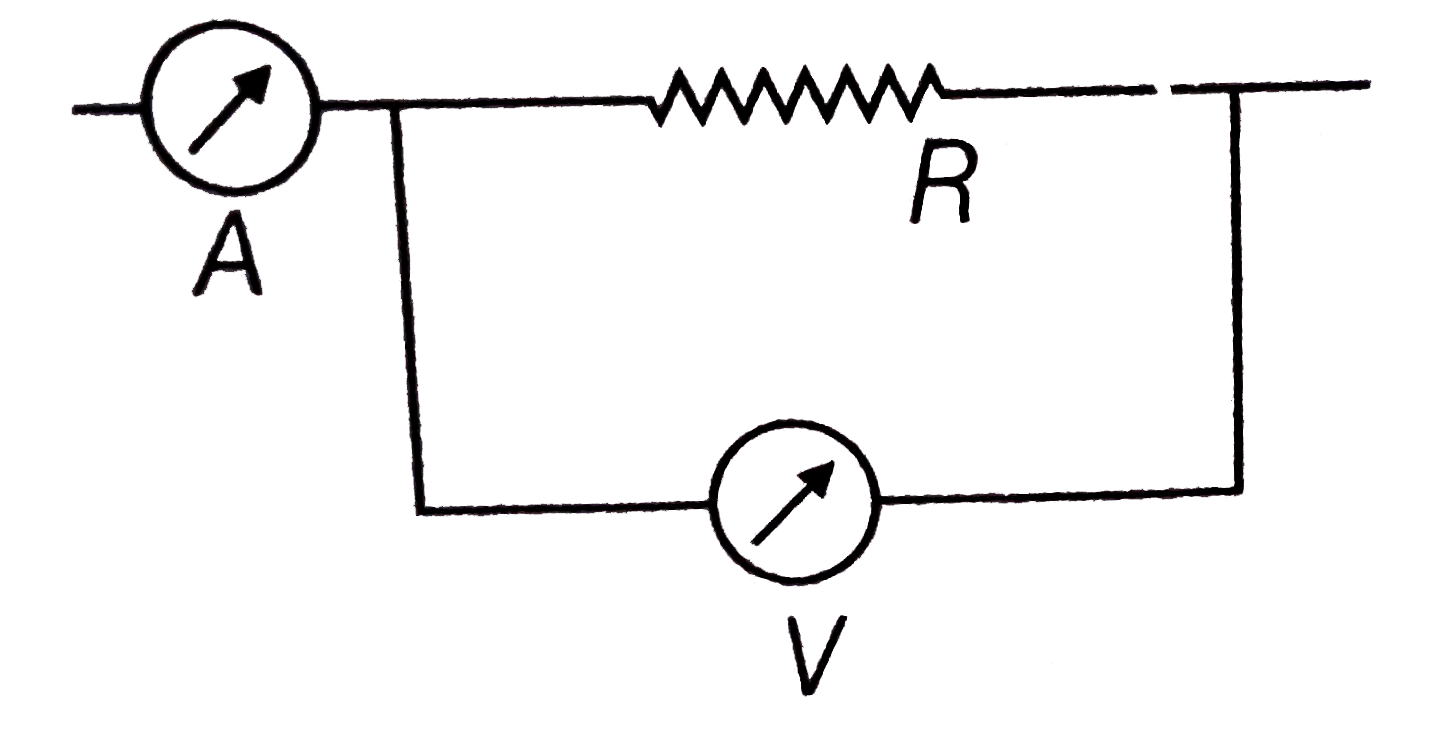Draw the circuit for experimental verfication of Ohm's law using a source of variable DC voltage, a main resistance of 100(Ω), two galvanometers and two resistances of values 106Ω and 10−3 respectively. Clearly show the positions of the voltmeter and the ammeter.
To draw the circuit for the experimental verification of Ohm's law using the specified components, follow these steps:
1. Identify the Components:
- You have a variable DC voltage source.
- A main resistance of 100 Ω.
- Two galvanometers (which will act as ammeter and voltmeter).
- Two resistances: one of value \(10^6 \, \Omega\) and another of value \(10^{-3} \, \Omega\).
2. Connect the Variable DC Voltage Source:
- Start by drawing the variable DC voltage source. This will be the power supply for the circuit.
3. Connect the Main Resistance:
- Connect the main resistance of 100 Ω in series with the variable DC voltage source. This is the load for the circuit.
4. Set Up the Ammeter:
- To create the ammeter, connect one galvanometer in series with the circuit.
- Connect the small resistance of \(10^{-3} \, \Omega\) in parallel with the galvanometer. This allows the galvanometer to measure the current flowing through the circuit without affecting the total current significantly.
5. Set Up the Voltmeter:
- To create the voltmeter, connect the second galvanometer in parallel with the main resistance (100 Ω).
- Connect the high resistance of \(10^6 \, \Omega\) in series with this galvanometer. This configuration ensures that the voltmeter measures the voltage across the main resistance without drawing significant current.
6. Label the Components:
- Clearly label the variable DC voltage source, the main resistance (100 Ω), the ammeter (with the small resistance), and the voltmeter (with the high resistance).
Final Circuit Diagram:
- The circuit should look like this:
±−−−−−−−−−−−−−−−−−−+|||Variab≤||DCSource|||±−−−−−−−−±−−−−−−−−+||±−±−+|100Ω|±−±−+||±−−−−−−−±−−−−−−−−+||||G1(Ammeter)G2(Vo<meter)||∣∣|±−+±−+|10−3Ω∣∣∣∣106Ω∣∣±−±−+±−±−+
- You have a variable DC voltage source.
- A main resistance of 100 Ω.
- Two galvanometers (which will act as ammeter and voltmeter).
- Two resistances: one of value \(10^6 \, \Omega\) and another of value \(10^{-3} \, \Omega\).
- Start by drawing the variable DC voltage source. This will be the power supply for the circuit.
- Connect the main resistance of 100 Ω in series with the variable DC voltage source. This is the load for the circuit.
- To create the ammeter, connect one galvanometer in series with the circuit.
- Connect the small resistance of \(10^{-3} \, \Omega\) in parallel with the galvanometer. This allows the galvanometer to measure the current flowing through the circuit without affecting the total current significantly.
- To create the voltmeter, connect the second galvanometer in parallel with the main resistance (100 Ω).
- Connect the high resistance of \(10^6 \, \Omega\) in series with this galvanometer. This configuration ensures that the voltmeter measures the voltage across the main resistance without drawing significant current.
- Clearly label the variable DC voltage source, the main resistance (100 Ω), the ammeter (with the small resistance), and the voltmeter (with the high resistance).
- The circuit should look like this:
Topper's Solved these Questions
- BOOK - DC PANDEY ENGLISHCHAPTER - EXPERIMENTSEXERCISE - Exercise 3.12videos
EXPERIMENTS
- BOOK - DC PANDEY ENGLISHCHAPTER - EXPERIMENTSEXERCISE - Exercise 3.22videos
EXPERIMENTS
- BOOK - DC PANDEY ENGLISHCHAPTER - ELECTROSTATICSEXERCISE - Integer17videos
ELECTROSTATICS
- BOOK - DC PANDEY ENGLISHCHAPTER - FLUID MECHANICSEXERCISE - Medical entranes gallery49videos
FLUID MECHANICS
Similar Questions
Draw the circuit for experimental verification of Ohm's law using a source of variable DC voltage, a main resistance of 100Ω, two galvanometers and two resistances of value 106Ω and 10−3Ω respectively. Clearly show the positions of the voltmeter and the ammeter.
View Solutiontwo galvanometers of resistance 100Ωand50Ω, are 10−8A/div and 2×10−5A/div respectively. In which case the voltage sensitivity is more ?
View SolutionThe figure shows a source (a battery) with an emf E of 12 V with an internal resistance r of 2Ω and an external resistance of 4Ω is added to complete the circuit. What are the voltmeter and ammeter readings
 View Solution
View SolutionA galvanometer vaving 50 divisions provided with a variable shunt S is used to measure the current when conneted in series with a resistance of 90Ω and a battery of internal resistance 10Ω. It is observed that when the snt resistaces are 10Ω&70Ω respectively, the deflection are respectively 9 and 30 dividions. What is the resistance of the galvanometer ? Further, if the full scale deflection of the galvanometer movement require 200 mA. find the emf of the cell.
View SolutionTwo batteries with emf 12 V and 13V are connected in parallel across a load resistor of 10Ω . The internal resistances of the two batteries are 1Ωand2Ω respectively . The voltage across the load lies between
View SolutionA galvanometer having 50 divisions provided with a variable shunt S is used to measure the current when connected in series with a resistance of 90Ω and a battery of internal resistance 10Ω. It is observed that when the shunt resistances are 10Oemga and 50Ω, the deflections are, respectively, 9 and 30 divisions. What is the resistance of the galvanometer
View SolutionIn the adjoining circuit diagram, the readings of ammeter and voltmeter are 2 A and 120 V, respectively. If the value of R is 75Ω, then the voltmeter resistance will be
 View Solution
View SolutionThe resistance of galvanometer is g ohm and the range is 1 volt. The value of resistance used to convert it into a voltmeter of ragne 10 volt is:-
View SolutionThe senstivity of a galvanometer that measures current is decreased by 1/40 times by using shunt resistance of 10Ω . Then, the value of the resistance of the galvanometer is
View SolutionThe equivalent resistance of two resistor connected in series is 6Ω and their equivalent resistance is 43Ω. What are the values of resistances ?
View Solution

